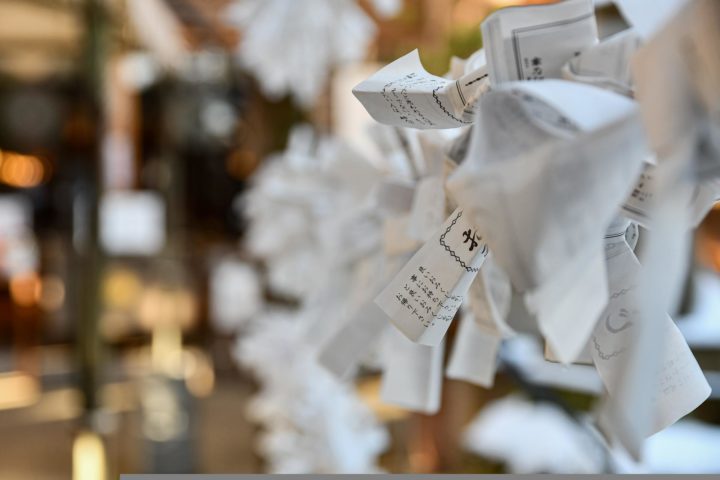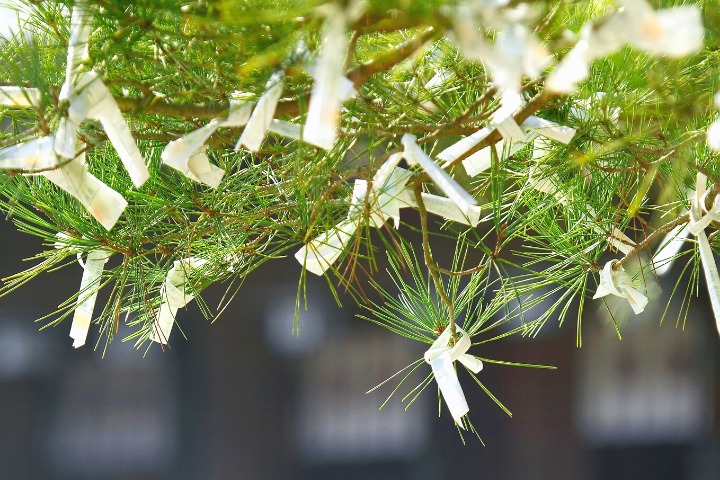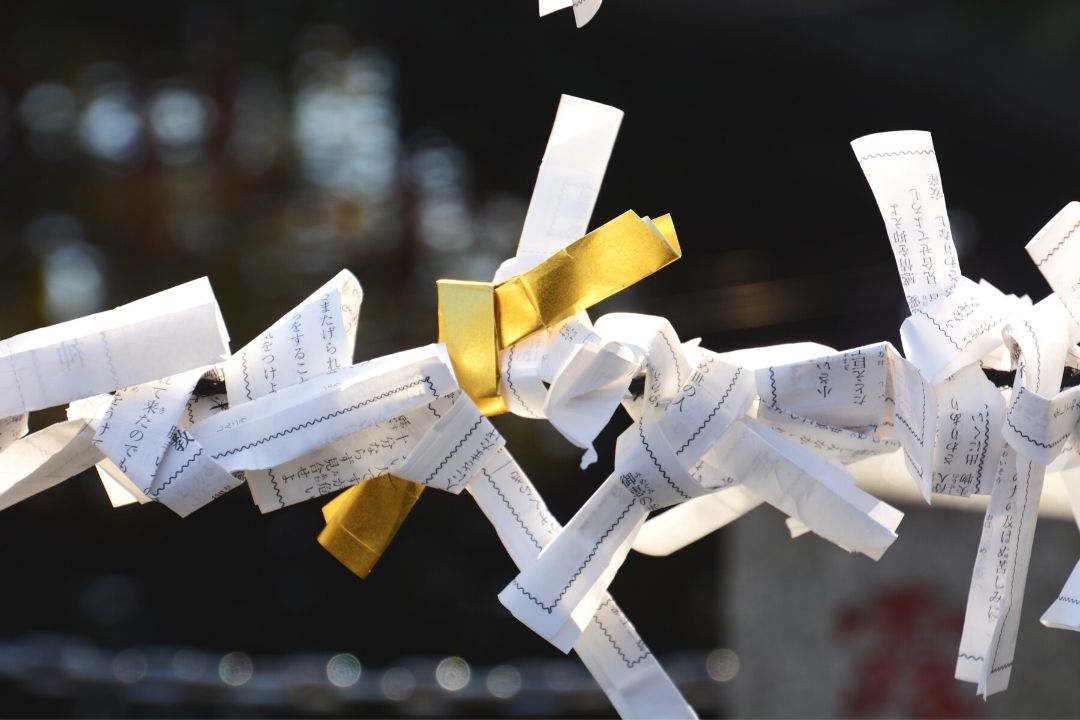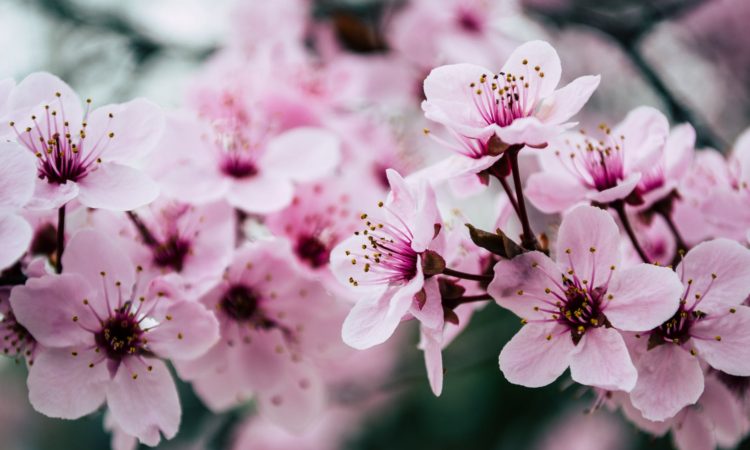This post is also available in:

Have you ever heard of omikuji (おみくじ) when visiting shrines or temples? If so, have you ever tried to follow the locals and choose an omikuji if you are familiar with the custom?
Omikuji is an old Japanese tradition that is still popular in present times. In this article, we will introduce fun and interesting facts regarding omikuji for those unfamiliar with the custom.
What is Omikuji?
Omikuji is originally a form of fortune-telling written on a paper with varying degrees of luck presented to predict the days ahead.
Like other types of fortune-telling, omikuji gives two categories of luck predictions, the good and the bad. Make sure you wish for good luck while choosing your omikuji!
After selecting an omikuji, you unroll the small slip of paper to see your luck written within.

Photo credit: Johnnys_pic (Pixabays)
Your omikuji will predict luck in several aspects of your life, such as health, romance, wealth, and general life.
Japanese people love to spend the first day of the new year reading their omikuji to predict the year ahead.
The omikuji itself often comes in the form of a small folded paper, sometimes tied with a ribbon. You open it up to read the predictions.
Usually, it will use some form of old Japanese written with difficult kanji, which may be hard to read—even for native Japanese speakers. Don’t worry! Usually, someone will be nearby and you can ask them for help.
A Brief Overview
Historically, the omikuji tradition came from Japanese Buddhist temples attributed to the Heian period Tendai monk Ryogen (912-985).
They contained a sequence of written five-character quatrains, which are popularly known as the Ganzan Daishi Hyakusen (元三大師百箋).

Photo credit: Canva
The inclusion of Ganzan Daishi Hyakusen in omikuji gained popularity during the Edo Period, and they have remained ever since.
Good and bad fortunes are shown in omikuji, made up of ancient traditional kanji. We have summed up some of the most common words used to predict fortunes as follows:
- Great blessing (大吉, dai-kichi)
- Middle blessing (中吉, chū-kichi)
- Small blessing (小吉, shō-kichi)
- Blessing (吉, kichi)
- Half-blessing (半吉, han-kichi)
- Future blessing (末吉, sue-kichi)
- Small future blessing (末小吉, sue-shō-kichi)
- Bad luck (凶, kyō)
There are also some terms related to your more specific fortune which are as follows:
- Hōgaku (方角) – auspicious/inauspicious directions
- Negai-goto (願事) – one’s wish or desire
- Machibito (待人) – a person being waited for
- Usemono (失せ物) – lost article(s)
- Tabidachi (旅立ち) – travel
- Akinai (商い) – business dealings
- Gakumon (学問) – studies or learning
- Sōba (相場) – market speculation
- Arasoigoto (争事) – disputes
- Ren-ai (恋愛) – romantic relationships
- Tenkyo (転居) – moving or changing residence
- Shussan (出産) – childbirth, delivery
- Byōki (病気) – illness
- Endan (縁談) – marriage proposal or engagement
So, now you know what is written on the folded paper of omikuji, make sure not to mix up the bad luck and the good fortune!
How to Obtain an Omikuji?
Usually, you can find omikuji in any Shinto shrine or Buddhist temple in Japan.
Omikuji are often available near the main gate to welcome visitors. Put some change in the box and then randomly choose your future. Or some shrines or temples only offer omikuji from the desk that sells omomori (protection charms).

Photo credit: Canva
What if I get a bad fortune? In Japan, there is a traditional custom to fold your omikuji into a strip and tie it to a pine tree or designated place with the other bad fortunes. This is to avoid the fortune coming true. After which the priests of the temple or shrine will burn it, therefore burning the bad luck, too.
Did you know you are meant to put your bad fortune on a pine tree because pine tree in Japanese is “松 or “matsu,” which has the same pronunciation as “待つ,” meaning “wait”? This is in the hope that the bad luck will wait and lurk in the background.
When it comes to receiving a good prediction, people usually keep the fortune in their wallets or attach it to the tree in the yards of their house. They believe this makes the predicted fortune even more potent.
You can find omikuji in almost every shrine and temple all around Japan and most people don’t miss out on a chance to pick their fortunes when visiting temples and shrines.
Do You Want to Try Choosing Your Fortune with Omikuji?
If you are one of those people who loves to delve deeper into Japanese traditional culture, omikuji is definitely the way to start.
You can find it at the Shinto shrines or Buddhist temples around the country and get your fortune-telling folded paper anytime.
The best of fortunes is waiting for you ahead. Good luck!
Devy Mufliha,
Indonesia
Related Articles:
- New Year In Japan: 7 Uniquely Japanese Traditions
- Visiting Temples And Shrines In Japan; 13 Things To Know!
- 5 Love Shrines in and around Tokyo
- Understand Religion in Japan: Shinto and Related Cultures
Feautrued photo credit: Canva






